CHAPTER 20
American Ballet Theatre
Even with
the failure of the disastrous Hamlet with its star cast, ABT must
have been well pleased with the work I’d done while there because I
was offered an extended contract. It is never easy to establish
yourself as a choreologist with any dance company, let alone a big,
major company such as ABT. For one thing, Choreology and
Labanotation in America are not all that well known. Previously,
dancers always relied on memory in revising ballets, that is, until
the choreologists came along. I should say here that ballet masters
and rehearsal directors have been known to resent a choreologist on
staff, I suppose considering notation a possible threat to their own
job. After all, an entire ballet written down in detail is a
distinct advantage over someone who often has only a vague memory of
the work, and the more useful choreologists make themselves, the
greater the danger.
Now, in the
present age of video and computer technology, is notation then
obsolete, dying or already dead? As I am writing here mainly about
notation as a profession in America I would have to say a complex
yes, but in Europe it’s a different story. Unlike in this country,
Governments there, and elsewhere, are not shy or stingy about
funding the arts. Simply put, American dance companies as a rule
can’t afford the luxury of a full-time notator on staff. If they
want to add to their repertory a ballet by a leading choreographer,
say from Europe, a choreologist most likely is sent over to stage
it, and yes, from a notation score. Choreologists attach themselves
to certain choreographers, becoming familiar with their style and
working methods as well as full details of the actual steps and
staging.
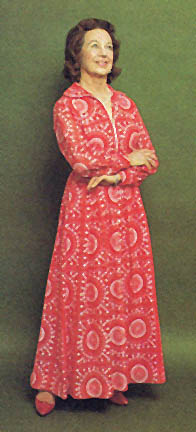 American
Ballet Theatre, known originally as Ballet Theater, was founded by
Lucia Chase in 1940. Fabulously wealthy, she poured millions into
bringing together the greatest names in ballet and establishing the
company as world class, although it remained always on the brink of
bankruptcy. She was committed to preserving the great masterpieces
of classic ballet as well as nurturing the emerging modern American
choreographers, thereby ensuring a healthy dance legacy for future
generations. American
Ballet Theatre, known originally as Ballet Theater, was founded by
Lucia Chase in 1940. Fabulously wealthy, she poured millions into
bringing together the greatest names in ballet and establishing the
company as world class, although it remained always on the brink of
bankruptcy. She was committed to preserving the great masterpieces
of classic ballet as well as nurturing the emerging modern American
choreographers, thereby ensuring a healthy dance legacy for future
generations.
Photo: Lucia Chase
Unlike
Rebekah Harkness, hers was not a fleeting interest in ballet,
playing the patroness to young choreographers of advanced ideas but
mediocre ability. Lucia Chase was energetic, executive.
I went
immediately to their nifty offices on Seventh Avenue to sign the
contract. The studios at that time were located on two top floors of
a building on West Sixty-Third Street, just off Columbus Circle. It
had a rabbit warren of studios where the company, while not on tour,
rehearsed all day long. In the evenings, the ABT School took over
the studios. Surprisingly, I found still teaching there one of my
very first teachers from twenty-five years earlier in ABTs original,
tiny studio on West Fifty-Sixth Street; Valentina Pereyaslavic, with
her accompanist, Valya Vishnevskaya.
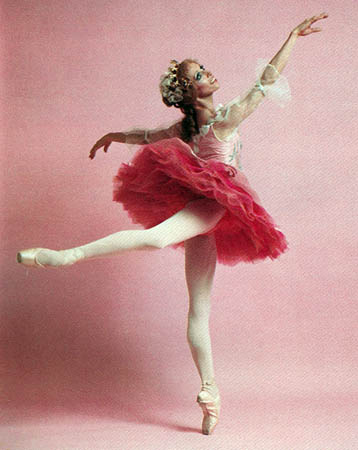 The
ABT company ballet masters were Enrique Martinez, Michael Lland,
Scott Douglas, and Jurgen Schnieder. Terry Orr, a principal dancer
was also given the responsibility to rehearse certain ballets. The
ABT company ballet masters were Enrique Martinez, Michael Lland,
Scott Douglas, and Jurgen Schnieder. Terry Orr, a principal dancer
was also given the responsibility to rehearse certain ballets.
The ABT
stars, besides “Misha” Baryshnikov, were other Soviet defectors,
Natasha Makarova and Sasha Mintz. Then there was the American Prima
Ballerina, Cynthia Gregory, the Dutch Martine Van Hammel, the
ever-reliable Eleanor D’Antuono, originally from Boston, Gelsey
Kirkland, ballet’s “bad girl” whose drug dependence nearly ruined
her career, the charming Hungarian, Ivan Nage, and the fantastic
danseur noble, Fernando Bujones - no other American ballet company
could boast such luminaries.
Photo: Natalia Makarova
On my first
day I was placed in a baptism of fire. I no sooner arrived, than
Martinez had me accompany him to a rehearsal of the vision scene in
“Sleeping Beauty”. After five minutes he vanished, leaving me to
carry on to rehearse twenty-four ballerinas who didn’t even know who
I was. Fortunately, I had just finished staging a Sleeping Beauty in
Pennsylvania so knew this scene well.
Afterwards,
in the lobby, I ran into Nina, a friend of mine who knew practically
everyone in the ballet world. She was Mexican but spoke perfect
Russian and through her, I had met most of the Bolshoi Ballet people
when they were in town.
“Pozdravlyayou” she said in Russian [congratulations]. This was
because we often had talked about how great it would be if I could
be a part of ABT, which to us both seemed so unlikely.
Baryshikov’s Nutcracker
Baryshnikov was starting to choreograph a new “Nutcracker”. Being
his first effort at choreography he was, understandably, a bit
nervous and he searched for help from every direction.
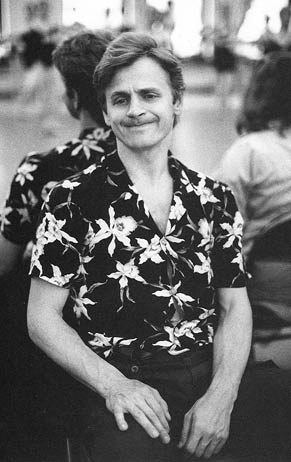 We
of course knew each other from the earlier episode with Neumeier’s
“Hamlet”. Misha had been sort of chummy with me then, but as he
became more and more famous, his attitude gradually changed to, I
would have to say, arrogance. His arrogance stretched to mostly
everyone else as well. Like Rudolph Nureyev before him, his fame had
spread far beyond just a ballet audience to full media attention and
National recognition. Never shy, he had no trouble in learning the
American ways fast, and the inside politics of ballet companies. We
of course knew each other from the earlier episode with Neumeier’s
“Hamlet”. Misha had been sort of chummy with me then, but as he
became more and more famous, his attitude gradually changed to, I
would have to say, arrogance. His arrogance stretched to mostly
everyone else as well. Like Rudolph Nureyev before him, his fame had
spread far beyond just a ballet audience to full media attention and
National recognition. Never shy, he had no trouble in learning the
American ways fast, and the inside politics of ballet companies.
Photo: Misha directs a rehearsal
This ‘troika’
of defectors: Misha, Sasha and Natasha, stayed mostly together,
discussing how they should do Nutcracker. Jurgen Schneider also, who
although German, gained his training along with them in Leningrad.
That circle was closed to me, but during their discussions they
didn’t know that I was Russian speaking and understood mostly
everything they said, which was not very complimentary about ABT and
many of its staff.
Nutcracker
rehearsals were my main concern then, and getting it all notated.
But of course as resident choreologist, there were other rehearsals
to attend to.
Sir Robert Helpmann
Sir Robert Helpmann arrived to re-stage a “Sleeping Beauty”. He had
been one of the most famous of British male dancers from the 30s and
40s. He was also a movie dancer/actor starring in many films, such
as
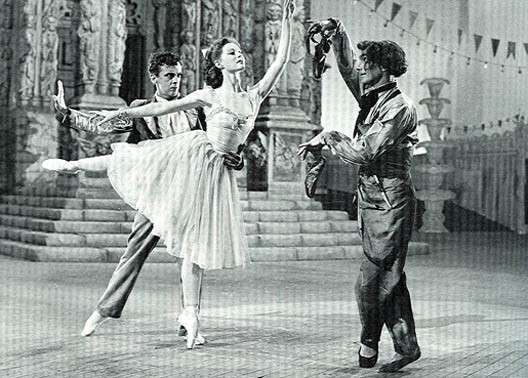 1948
ground-breaking “The Red Shoes” and “Tales Of Hoffman”. Strictly as
an actor he had acted with Katherine Hepburn, Bette Davis, Charlton
Heston, and many other Hollywood stars. He was actually working in
two movies at the time and would often tell me he was off to have
lunch with Katherine Hepburn or some other notable movie queen. 1948
ground-breaking “The Red Shoes” and “Tales Of Hoffman”. Strictly as
an actor he had acted with Katherine Hepburn, Bette Davis, Charlton
Heston, and many other Hollywood stars. He was actually working in
two movies at the time and would often tell me he was off to have
lunch with Katherine Hepburn or some other notable movie queen.
Photo: Sir Robert Helpmann in the
1948 British film "The Red Shoes" with Moira Shearer and Leonide
Massine.
We became good friends, not only because I, having spent so many
years in England, understood the British customs and manners, but
because of my ready and eager desire to help.
From the
beginning it became clear that he had little knowledge of the actual
choreography for Sleeping Beauty. He began to flounder and hesitate.
He remembered almost nothing of the steps, although he had danced it
countless times with England’s great Prima Ballerina, Margot Fonteyn.
Like my previous experience with “The Dream, he seemed, like Sir
John Hart, overjoyed at having a ready source of knowledge and made
continuous use of it, although he did have a wonderful understanding
of dramatic values and theater sense.
The dancers
had already been doing a version set by Mary Skeaping, so it was
just a matter of adjusting it here and there. Skeaping had left some
very odd ideas in her staging. Helpmann thought the Skeaping version
was rubbish, and said so to ABT officials. I loved his humorous
comments, so English. Like when at the dress rehearsal, the Lilac
Fairy made her exit in a device that was pulled up into the flies.
He whispered to me, “I asked for a basket and they built me the
Queen Mary”!
He was
somewhere in his eighties, with a mass of white hair and those
famous, bulging eyes. My suggestions took immediate hold of him and
I came to be constantly at his side as he more and more began to
rely on me. I could see he knew only some of the obvious bits, but
rather than completely taking over I merely would hint or suggest.
Sitting beside
him during rehearsals, every few minutes I would have to, tactfully,
lean over and say something like: “Shouldn’t they be doing
mazurka step here? Then he would slap his knee and say something
like: “I KNEW there was something wrong” - even though it had
completely escaped his notice.
The six fairy
variations were all wrong the way Skeaping had set them. To correct
them and other sections, I used a score from the Royal Ballet. It
became my bible and so dog-eared after two months of use, it was
barely readable.
Glenn Tetley’s “Sacre du Primtemps”
We were also rehearsing Glenn Tetley’s version of “Sacre du
Printemps”. The score I had to work with was written by another
choreologist and it was in most part, incomprehensible. Instead of
being notated straight through as it was danced, it was more like;
‘go back to section B’ or ‘repeat section D to F’ etc. so it was
cumbersome and time consuming just trying to read and locate
sections when it should have been straight on. Fortunately, Scott
Douglas, who had been one of ABTs top dancers, was an expert
repetiteur and remembered the ballet nearly step by step.
Being so involved with “Beauty” left me little time for Misha’s
“Nutcracker” but I somehow managed to attend all those rehearsals as
well notating it as carefully and as quickly as I could. Misha too
seemed to at times rely on me, even one day inviting me to join in
with the boys as they were learning a dance. It was a stressful
time. I would put in a full day at the studios, only to arrive home
to work some more on the scores before I forgot what my rapid notes
made during the day meant.
Misha’s Nutcracker A Success
“Nutcracker” opened in Washington, DC at the Kennedy Center. I
stayed with the dancers at the “Hotel Intrigue” across the street
from Watergate. The same as with the Harkness Ballet, company
officials never knew exactly where to book the choreologist - with
the staff or with the dancers. It should be with the staff, but I
didn’t mind at all being shoved along with the corps dancers. It was
a season of intense winter cold in Washington. Out of my window I
could look at Watergate and the Kennedy Center, covered with snow.
Jimmy McWhorter, who was my assistant back in the early days with
Tucson Civic Ballet, was living in Falls Church, Virginia, just
across the Potomac from Washington, D.C. He was by then married with
2 young children. Being a cellist in the Air Force orchestra, he
often played at the White House. I spent an afternoon showing him
and his family around backstage at Kennedy Center.
As is the
case while touring with ballet companies, only the hotel and theater
are seen.
Misha’s new
Nutcracker was a big success, partly because he himself danced the
leading role, although, in my opinion, Fernando Bujones was a more
elegant dancer but did not have the star appeal. Soviet defectors
were almost always guaranteed to be the reigning stars, even if
there were others who surpassed them in dance technique.
ABT’s Star Power
Rebecca Wright showed up from Joffrey Dream. A dancer with
remarkable precision and power. She always danced full out with
impeccable footwork, clearly shaped port de bras and infallible
musicality. She died in 2005 at age 58 after a prolonged battle with
cancer.

Eric Bruhn, a true gentleman in every sense and the perfect
male dancer. He later became director of the National Ballet
of Canada and died in 1987 of lung cancer. I do remember him
smoking a lot.
Ivan
Nage, a sense of wit and humor, always playing jokes. Once,
during a performance of “Les Sylphides” in which he danced
the leading male role of the poet, I happened to be standing
in the wings downstage left, as I usually did. Just as he
was making his entrance in the coda, he suddenly grabbed my
hand to pull me onstage along with him. I think he actually
would have if I hadn’t resisted with full force.
Photo: Ivan Nage |
| |
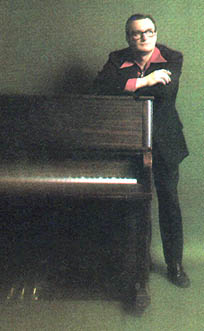 Makarova
- always pounding her point shoes and holding up rehearsals! While
rehearsing her in the role of Aurora in Sleeping Beauty I made a
horrible faux pas by showing her the way I’d remembered Margot
Fonteyn dancing it. It looked like I was comparing, which is never
done with prima ballerinas and certainly not one of Makarova’s
stature. I thought I would be fired after that but ballet master
Michael Lland told me she had probably forgotten it instantly. Makarova
- always pounding her point shoes and holding up rehearsals! While
rehearsing her in the role of Aurora in Sleeping Beauty I made a
horrible faux pas by showing her the way I’d remembered Margot
Fonteyn dancing it. It looked like I was comparing, which is never
done with prima ballerinas and certainly not one of Makarova’s
stature. I thought I would be fired after that but ballet master
Michael Lland told me she had probably forgotten it instantly.
Photo: Michael Lland, Ballet
Master
Natasha was always accompanied by Dina Makarova, same name but not
related. It was interesting overhearing them always gossiping and
complaining in Russian, not knowing that I understood.
Fernando
Bujones, always the gentleman, with impeccable technique and the
ideal classical male dancer. Tall and slim, he was one of the few
who could partner Cynthia Gregory, who always, due to her height,
had the problem of finding a suitable partner. He died from melanoma in 2005 at
the age of fifty. A great loss.
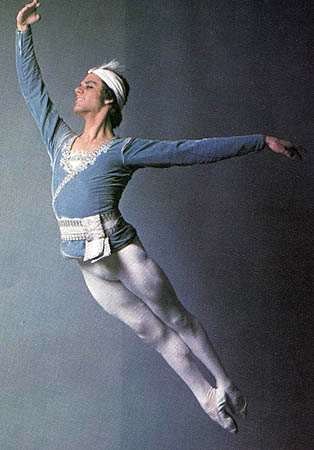 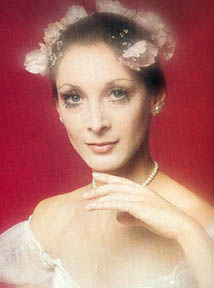
Photo Left: Fernando Bujones
Photo Right: Cynthia Gregory
|
|
Cynthia had
actually retired but made a come-back at the same time I joined.
 Gelsey
Kirkland, a lithe and exquisite dancer. She was going through a
serious drug problem at the time, which she wrote about extensively
in her book “Dancing On My Grave”. She was also then having a
romance with Misha, quite obvious to us all. Gelsey
Kirkland, a lithe and exquisite dancer. She was going through a
serious drug problem at the time, which she wrote about extensively
in her book “Dancing On My Grave”. She was also then having a
romance with Misha, quite obvious to us all.
Photo: Gelsey Kirkland
And Baryshnikov. Aloof and with a shimmering bravura technique.
Obviously the show was his from start to finish.
Returning to New York there was a full month of just “Coppelia” at
the City Center. It was a tiresome version by Enrique Martinez but
came to life with Gregory and Makarova.
Firebird And Petrushka
The ABT Spring season, from April through June began at the Met. The
two new productions that interested me most were “Firebird” and “Petrushka”.
Choreologist
Christopher Newton from Royal Ballet arrived to set “Firebird”.
Another
choreologist, and a congenial one. He was perhaps the only other
choreologist I ever found to be truly friendly. Few of the others
had ever shared or given me any kind of real support.
The Fokine
version of “Firebird” is nearly an hour in length. After Christopher
left I had to rehearse it myself from the score that he left in my
hands, which was from the Royal Ballet. The Royal is a much bigger
company than ABT, and therefore corps parts had to be reduced for
the smaller ABT corps. Not as easy as it sounds.
“Petrushka”
was not exactly new. It was one of the last ballets it’s
choreographer Mikhail Fokine himself
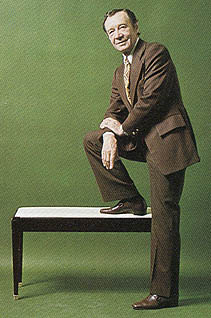 had
set on ABT before he died in 1942. Dimitri Romanov, long-time ballet
master at ABT had danced in it at that time. As with most Russians,
I got on well with him. He liked my rehearsal comments and
assistance and always was putting a word in for me to Lucia Chase. had
set on ABT before he died in 1942. Dimitri Romanov, long-time ballet
master at ABT had danced in it at that time. As with most Russians,
I got on well with him. He liked my rehearsal comments and
assistance and always was putting a word in for me to Lucia Chase.
Photo: Dimitri Romanov, Regesseur
Watching both
of these Diaghilev ballets from the wings was always thrilling, to
me at least - the dancers thought them boring. All my "virtual"
Russian blood would surge each time I watched the wedding finale of
Firebird, with the boyars, dressed in fantastic costumes marching
upstage to the glorious Stravinsky chorale.
Backstage at
each performance, I studied every detail of the Petrushka sets; the
merry-go-round, the way the puppet theater was put together, the
mechanism of how the snow fell, thinking that one day I may even
produce it myself.
It’s always interesting for me to observe dancer’s behavior when out
of view. For instance, audiences would be shocked to see backstage
when a dancer bounds into the wings at the end of a difficult and
exhausting variation and bends over in physical agony, gasping for
breath. Not the picture to take home. Ballet dancers, both male and
female, must have strength and endurance far exceeding most sports
athletes.
In the Metropolitan Opera house, where I had once danced, I now had
my own office. I had apparently reached the peak of my career. For a
choreologist, ABT was just about as far as one could go in this
country. It was the top in prestige and salary. Actually, the salary
was then commensurate with that of a soloist.
When the company went out on tour, to San Francisco, to London, I
stayed behind, free to join the staff at the Dance Notation Bureau
until they returned. I used the time to tidy up my scores and
involve myself in life at the Bureau. I used the time to complete
from my notes the scores of Coppelia, Les Patineurs, La Bayadère, La
Sylphide, Petrushka and Nutcracker.
Antony Tudor
The leading, resident choreographer at ABT was
Antony Tudor - real
name, William Cook. He was born
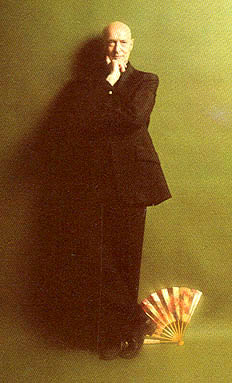 1908
in London of lower-middle-class. Being myself from a lower class, I
appreciated his being able to pull himself up from it. He had been
with ABT from it’s very beginning in 1940 and considering the ABT
hierarchical nature, he demanded, and got the most respect. 1908
in London of lower-middle-class. Being myself from a lower class, I
appreciated his being able to pull himself up from it. He had been
with ABT from it’s very beginning in 1940 and considering the ABT
hierarchical nature, he demanded, and got the most respect.
Describing how he happened to come from his native England to
dance and choreograph for ABT during the initial season in 1940:
"Actually my invitation was an after-thought, the directors had
first invited Frederick Ashton to join them, but when he was unable
to come, they asked me. How lucky for me Freddie couldn't make it."
He had a
reputation of being extremely difficult for anyone to work with.
Unfriendly, sarcastic, cruel. He caused so many dancers to run out
of class or rehearsal in tears.
Photo: Antony Tudor,
Choreographer Emeritus
I knew him from the early days as a student in the old Met ballet
school. It was when Ballet Theater took over the Met dancers in
1950. A classmate and I hid in the upper reaches of the immense roof
stage studio to watch as Tudor, with a stony, expressionless face,
and a smiling Lucia Chase, auditioned and eliminated the ballet
company already in residence, with the exception of one of two. The
dancers, we thought, were cruelly cast aside as unsuitable and
replaced with a new crop. Zachery Solov became the Met’s new
resident choreographer. That’s when my classes at the old Met came
to an end, as Tudor refused to let me continue on as a non-paying
student. Bronislava Nijinska at the new ABT School did, however.
The Met
Ballet School re-started in the new house in Lincoln Center but
limited to evening classes.
One afternoon, backstage, after I had danced in a matinee of “Aida”,
Tudor told me that it might be a good idea if some of the dancers
learned Benesh notation and suggested I put a notice on the studio
bulletin board announcing that I would be willing to instruct them.
I took his advice and found several who were genuinely interested.
Typically, he neglected to tell anyone else about his suggestion.
ballet mistress Audrey Keane felt, and rightly so, that I should
have first consulted her before doing this, and sent me to General
Manager Rudolf Bing’s office for a reprimand. Mr. Bing was used to
Tudor’s inconsistencies however, and all was forgiven.
Sunflowers
The Dance Notation Bureau wanted me to stage Tudor’s “Sunflowers”
for the Met Opera Ballet.
Tudor had very strong views on how his ballets should be staged and
I got the impression he did not welcome this news. Even though I had
been sent with full approval by the Bureau to do this,
reconstructions through notation at that time were still considered
to be somewhat suspicious. And after all, who was I, who had never
even danced in any of his ballets, to be qualified to take on the
job?
Backstage at the Met I cornered him in an elevator where he assumed
I was going to ask him for steps. He gave me a scornful grunt, not
unusual for Tudor’s reaction to anyone who approached him. “I
wouldn’t think of asking you for steps” I said in a cocky sort of
way. "I just wanted to get some insight from you on casting your
ballet”. His well known harshness didn’t scare me any longer
and I had begun to discover that when I had to deal with overbearing
people, their arrogance only diminished my respect for them. Sensing
that bluffs were not going to work on me, their attitude often
changed. Others in the elevator stared in disbelief at hearing me
speak so boldly and impudently to Tudor. Had I offended some subtle
etiquette by my lack of awe? On the other hand, I thought, if he is
the right kind of man, surely he will understand and brush aside a
mere lapse of convention. This happened! He beamed, and obligingly
gave me a complete cast to work with. But underneath he was forming
a sinister plot as I was later to find out.
When ABT finished the seven week season at the Met they went on tour
to Europe. I was left behind this time. But I had plenty to do with
Sunflowers. Since I had once been a member of the Met ballet, they
still considered me to be one of them and didn’t know exactly how to
accept me as their teacher. Some were a bit envious that I had gone
on to, what they might have considered better things.
After two weeks of rehearsing the dancers and with the ballet nearly
all taught, Tudor suddenly appeared at my rehearsal, un-announced.
As if on a whim, he completely changed the cast he had originally
given me! This looked as if I had done something wrong and meant I
had to start all over again teaching the already taught roles to
different dancers. In the end, the Met Ballet never did perform it.
Their dance director, Norbert Vesak had designed the costumes after
his own ideas which Tudor didn’t like and refused to allow it to be
danced. A lot of time and money wasted. Well, that was Tudor.
ABT In Turmoil
ABT was at that time going through many changes. Suddenly news came
that Baryshnikov, determined to dance for Balanchine, was leaving to
join New York City Ballet. There had been a re-shuffling of
management when the company manager, Daryl Dobson, one day walked
out of his office in a huff and never returned. Many of the dancers
were disgruntled. Then too, the first wave of the AIDS epidemic was
heart-wrenching, affecting many in dance, Broadway and Hollywood. At
any rate, I felt the time had come for a change. The hectic way in
which ballets were put together at ABT, the constant pressure and
rush. I felt I wanted to do something else on a more creative level.
After a year and
a half, Baryshnikov re-joined ABT as Company Director. Wondrous
results were expected. Instead came arbitrary firings of some of
ABT’s best dancers, along with promotions of Misha’s favorites who
were far from ready for major roles. One could reasonably assume he
was perhaps more concerned with his own career than in keeping alive
the traditions of ABT. He commissioned choreographers to do ballets
that Lucia Chase wouldn’t have given closet space to. Not until
Kevin McKenzie became director did the company begin to regain its
prestige as, rightfully, one of truly great ballet companies of the
world.
|
|
|
|
Copyright ©2006-2021 OKAY Multimedia |
|
|

 Makarova
- always pounding her point shoes and holding up rehearsals! While
rehearsing her in the role of Aurora in Sleeping Beauty I made a
horrible faux pas by showing her the way I’d remembered Margot
Fonteyn dancing it. It looked like I was comparing, which is never
done with prima ballerinas and certainly not one of Makarova’s
stature. I thought I would be fired after that but ballet master
Michael Lland told me she had probably forgotten it instantly.
Makarova
- always pounding her point shoes and holding up rehearsals! While
rehearsing her in the role of Aurora in Sleeping Beauty I made a
horrible faux pas by showing her the way I’d remembered Margot
Fonteyn dancing it. It looked like I was comparing, which is never
done with prima ballerinas and certainly not one of Makarova’s
stature. I thought I would be fired after that but ballet master
Michael Lland told me she had probably forgotten it instantly. 

 Gelsey
Kirkland, a lithe and exquisite dancer. She was going through a
serious drug problem at the time, which she wrote about extensively
in her book “Dancing On My Grave”. She was also then having a
romance with Misha, quite obvious to us all.
Gelsey
Kirkland, a lithe and exquisite dancer. She was going through a
serious drug problem at the time, which she wrote about extensively
in her book “Dancing On My Grave”. She was also then having a
romance with Misha, quite obvious to us all. had
set on ABT before he died in 1942. Dimitri Romanov, long-time ballet
master at ABT had danced in it at that time. As with most Russians,
I got on well with him. He liked my rehearsal comments and
assistance and always was putting a word in for me to Lucia Chase.
had
set on ABT before he died in 1942. Dimitri Romanov, long-time ballet
master at ABT had danced in it at that time. As with most Russians,
I got on well with him. He liked my rehearsal comments and
assistance and always was putting a word in for me to Lucia Chase. 1908
in London of lower-middle-class. Being myself from a lower class, I
appreciated his being able to pull himself up from it. He had been
with ABT from it’s very beginning in 1940 and considering the ABT
hierarchical nature, he demanded, and got the most respect.
1908
in London of lower-middle-class. Being myself from a lower class, I
appreciated his being able to pull himself up from it. He had been
with ABT from it’s very beginning in 1940 and considering the ABT
hierarchical nature, he demanded, and got the most respect. American
Ballet Theatre, known originally as Ballet Theater, was founded by
Lucia Chase in 1940. Fabulously wealthy, she poured millions into
bringing together the greatest names in ballet and establishing the
company as world class, although it remained always on the brink of
bankruptcy. She was committed to preserving the great masterpieces
of classic ballet as well as nurturing the emerging modern American
choreographers, thereby ensuring a healthy dance legacy for future
generations.
American
Ballet Theatre, known originally as Ballet Theater, was founded by
Lucia Chase in 1940. Fabulously wealthy, she poured millions into
bringing together the greatest names in ballet and establishing the
company as world class, although it remained always on the brink of
bankruptcy. She was committed to preserving the great masterpieces
of classic ballet as well as nurturing the emerging modern American
choreographers, thereby ensuring a healthy dance legacy for future
generations.  The
ABT company ballet masters were Enrique Martinez, Michael Lland,
Scott Douglas, and Jurgen Schnieder. Terry Orr, a principal dancer
was also given the responsibility to rehearse certain ballets.
The
ABT company ballet masters were Enrique Martinez, Michael Lland,
Scott Douglas, and Jurgen Schnieder. Terry Orr, a principal dancer
was also given the responsibility to rehearse certain ballets. We
of course knew each other from the earlier episode with Neumeier’s
“Hamlet”. Misha had been sort of chummy with me then, but as he
became more and more famous, his attitude gradually changed to, I
would have to say, arrogance. His arrogance stretched to mostly
everyone else as well. Like Rudolph Nureyev before him, his fame had
spread far beyond just a ballet audience to full media attention and
National recognition. Never shy, he had no trouble in learning the
American ways fast, and the inside politics of ballet companies.
We
of course knew each other from the earlier episode with Neumeier’s
“Hamlet”. Misha had been sort of chummy with me then, but as he
became more and more famous, his attitude gradually changed to, I
would have to say, arrogance. His arrogance stretched to mostly
everyone else as well. Like Rudolph Nureyev before him, his fame had
spread far beyond just a ballet audience to full media attention and
National recognition. Never shy, he had no trouble in learning the
American ways fast, and the inside politics of ballet companies.